Input interpretation
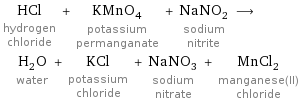
HCl hydrogen chloride + KMnO_4 potassium permanganate + NaNO_2 sodium nitrite ⟶ H_2O water + KCl potassium chloride + NaNO_3 sodium nitrate + MnCl_2 manganese(II) chloride
Balanced equation
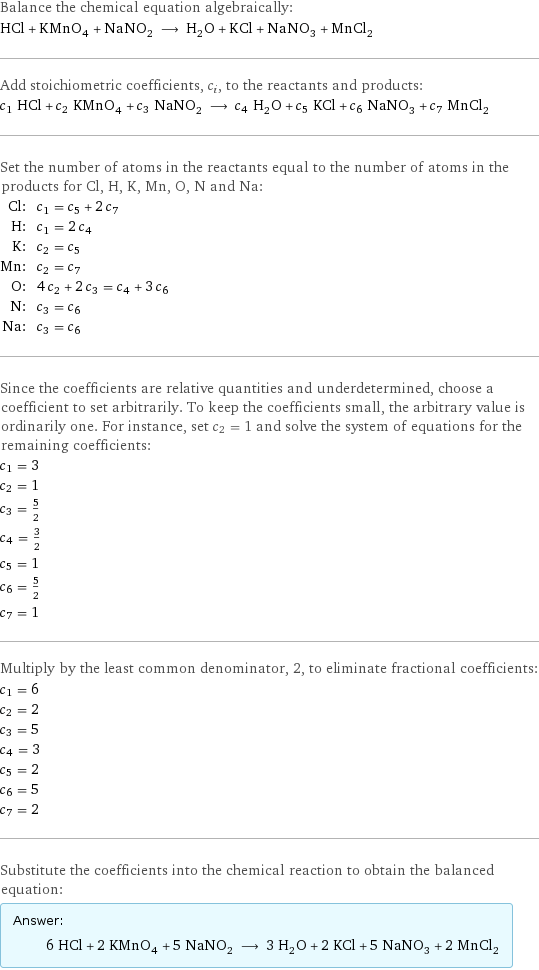
Balance the chemical equation algebraically: HCl + KMnO_4 + NaNO_2 ⟶ H_2O + KCl + NaNO_3 + MnCl_2 Add stoichiometric coefficients, c_i, to the reactants and products: c_1 HCl + c_2 KMnO_4 + c_3 NaNO_2 ⟶ c_4 H_2O + c_5 KCl + c_6 NaNO_3 + c_7 MnCl_2 Set the number of atoms in the reactants equal to the number of atoms in the products for Cl, H, K, Mn, O, N and Na: Cl: | c_1 = c_5 + 2 c_7 H: | c_1 = 2 c_4 K: | c_2 = c_5 Mn: | c_2 = c_7 O: | 4 c_2 + 2 c_3 = c_4 + 3 c_6 N: | c_3 = c_6 Na: | c_3 = c_6 Since the coefficients are relative quantities and underdetermined, choose a coefficient to set arbitrarily. To keep the coefficients small, the arbitrary value is ordinarily one. For instance, set c_2 = 1 and solve the system of equations for the remaining coefficients: c_1 = 3 c_2 = 1 c_3 = 5/2 c_4 = 3/2 c_5 = 1 c_6 = 5/2 c_7 = 1 Multiply by the least common denominator, 2, to eliminate fractional coefficients: c_1 = 6 c_2 = 2 c_3 = 5 c_4 = 3 c_5 = 2 c_6 = 5 c_7 = 2 Substitute the coefficients into the chemical reaction to obtain the balanced equation: Answer: | | 6 HCl + 2 KMnO_4 + 5 NaNO_2 ⟶ 3 H_2O + 2 KCl + 5 NaNO_3 + 2 MnCl_2
Structures
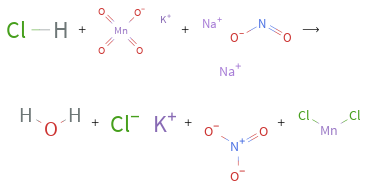
+ + ⟶ + + +
Names

hydrogen chloride + potassium permanganate + sodium nitrite ⟶ water + potassium chloride + sodium nitrate + manganese(II) chloride
Reaction thermodynamics
Gibbs free energy
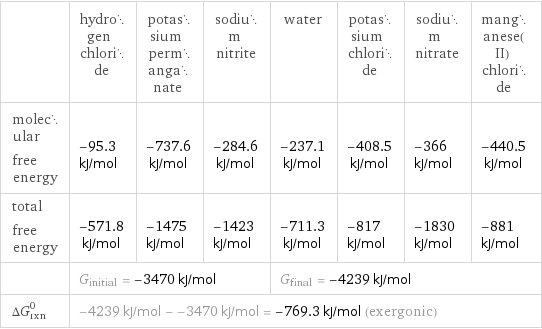
| hydrogen chloride | potassium permanganate | sodium nitrite | water | potassium chloride | sodium nitrate | manganese(II) chloride molecular free energy | -95.3 kJ/mol | -737.6 kJ/mol | -284.6 kJ/mol | -237.1 kJ/mol | -408.5 kJ/mol | -366 kJ/mol | -440.5 kJ/mol total free energy | -571.8 kJ/mol | -1475 kJ/mol | -1423 kJ/mol | -711.3 kJ/mol | -817 kJ/mol | -1830 kJ/mol | -881 kJ/mol | G_initial = -3470 kJ/mol | | | G_final = -4239 kJ/mol | | | ΔG_rxn^0 | -4239 kJ/mol - -3470 kJ/mol = -769.3 kJ/mol (exergonic) | | | | | |
Equilibrium constant
![Construct the equilibrium constant, K, expression for: HCl + KMnO_4 + NaNO_2 ⟶ H_2O + KCl + NaNO_3 + MnCl_2 Plan: • Balance the chemical equation. • Determine the stoichiometric numbers. • Assemble the activity expression for each chemical species. • Use the activity expressions to build the equilibrium constant expression. Write the balanced chemical equation: 6 HCl + 2 KMnO_4 + 5 NaNO_2 ⟶ 3 H_2O + 2 KCl + 5 NaNO_3 + 2 MnCl_2 Assign stoichiometric numbers, ν_i, using the stoichiometric coefficients, c_i, from the balanced chemical equation in the following manner: ν_i = -c_i for reactants and ν_i = c_i for products: chemical species | c_i | ν_i HCl | 6 | -6 KMnO_4 | 2 | -2 NaNO_2 | 5 | -5 H_2O | 3 | 3 KCl | 2 | 2 NaNO_3 | 5 | 5 MnCl_2 | 2 | 2 Assemble the activity expressions accounting for the state of matter and ν_i: chemical species | c_i | ν_i | activity expression HCl | 6 | -6 | ([HCl])^(-6) KMnO_4 | 2 | -2 | ([KMnO4])^(-2) NaNO_2 | 5 | -5 | ([NaNO2])^(-5) H_2O | 3 | 3 | ([H2O])^3 KCl | 2 | 2 | ([KCl])^2 NaNO_3 | 5 | 5 | ([NaNO3])^5 MnCl_2 | 2 | 2 | ([MnCl2])^2 The equilibrium constant symbol in the concentration basis is: K_c Mulitply the activity expressions to arrive at the K_c expression: Answer: | | K_c = ([HCl])^(-6) ([KMnO4])^(-2) ([NaNO2])^(-5) ([H2O])^3 ([KCl])^2 ([NaNO3])^5 ([MnCl2])^2 = (([H2O])^3 ([KCl])^2 ([NaNO3])^5 ([MnCl2])^2)/(([HCl])^6 ([KMnO4])^2 ([NaNO2])^5)](../image_source/2f339395bae6c0947fb279d84154aa6c.png)
Construct the equilibrium constant, K, expression for: HCl + KMnO_4 + NaNO_2 ⟶ H_2O + KCl + NaNO_3 + MnCl_2 Plan: • Balance the chemical equation. • Determine the stoichiometric numbers. • Assemble the activity expression for each chemical species. • Use the activity expressions to build the equilibrium constant expression. Write the balanced chemical equation: 6 HCl + 2 KMnO_4 + 5 NaNO_2 ⟶ 3 H_2O + 2 KCl + 5 NaNO_3 + 2 MnCl_2 Assign stoichiometric numbers, ν_i, using the stoichiometric coefficients, c_i, from the balanced chemical equation in the following manner: ν_i = -c_i for reactants and ν_i = c_i for products: chemical species | c_i | ν_i HCl | 6 | -6 KMnO_4 | 2 | -2 NaNO_2 | 5 | -5 H_2O | 3 | 3 KCl | 2 | 2 NaNO_3 | 5 | 5 MnCl_2 | 2 | 2 Assemble the activity expressions accounting for the state of matter and ν_i: chemical species | c_i | ν_i | activity expression HCl | 6 | -6 | ([HCl])^(-6) KMnO_4 | 2 | -2 | ([KMnO4])^(-2) NaNO_2 | 5 | -5 | ([NaNO2])^(-5) H_2O | 3 | 3 | ([H2O])^3 KCl | 2 | 2 | ([KCl])^2 NaNO_3 | 5 | 5 | ([NaNO3])^5 MnCl_2 | 2 | 2 | ([MnCl2])^2 The equilibrium constant symbol in the concentration basis is: K_c Mulitply the activity expressions to arrive at the K_c expression: Answer: | | K_c = ([HCl])^(-6) ([KMnO4])^(-2) ([NaNO2])^(-5) ([H2O])^3 ([KCl])^2 ([NaNO3])^5 ([MnCl2])^2 = (([H2O])^3 ([KCl])^2 ([NaNO3])^5 ([MnCl2])^2)/(([HCl])^6 ([KMnO4])^2 ([NaNO2])^5)
Rate of reaction
![Construct the rate of reaction expression for: HCl + KMnO_4 + NaNO_2 ⟶ H_2O + KCl + NaNO_3 + MnCl_2 Plan: • Balance the chemical equation. • Determine the stoichiometric numbers. • Assemble the rate term for each chemical species. • Write the rate of reaction expression. Write the balanced chemical equation: 6 HCl + 2 KMnO_4 + 5 NaNO_2 ⟶ 3 H_2O + 2 KCl + 5 NaNO_3 + 2 MnCl_2 Assign stoichiometric numbers, ν_i, using the stoichiometric coefficients, c_i, from the balanced chemical equation in the following manner: ν_i = -c_i for reactants and ν_i = c_i for products: chemical species | c_i | ν_i HCl | 6 | -6 KMnO_4 | 2 | -2 NaNO_2 | 5 | -5 H_2O | 3 | 3 KCl | 2 | 2 NaNO_3 | 5 | 5 MnCl_2 | 2 | 2 The rate term for each chemical species, B_i, is 1/ν_i(Δ[B_i])/(Δt) where [B_i] is the amount concentration and t is time: chemical species | c_i | ν_i | rate term HCl | 6 | -6 | -1/6 (Δ[HCl])/(Δt) KMnO_4 | 2 | -2 | -1/2 (Δ[KMnO4])/(Δt) NaNO_2 | 5 | -5 | -1/5 (Δ[NaNO2])/(Δt) H_2O | 3 | 3 | 1/3 (Δ[H2O])/(Δt) KCl | 2 | 2 | 1/2 (Δ[KCl])/(Δt) NaNO_3 | 5 | 5 | 1/5 (Δ[NaNO3])/(Δt) MnCl_2 | 2 | 2 | 1/2 (Δ[MnCl2])/(Δt) (for infinitesimal rate of change, replace Δ with d) Set the rate terms equal to each other to arrive at the rate expression: Answer: | | rate = -1/6 (Δ[HCl])/(Δt) = -1/2 (Δ[KMnO4])/(Δt) = -1/5 (Δ[NaNO2])/(Δt) = 1/3 (Δ[H2O])/(Δt) = 1/2 (Δ[KCl])/(Δt) = 1/5 (Δ[NaNO3])/(Δt) = 1/2 (Δ[MnCl2])/(Δt) (assuming constant volume and no accumulation of intermediates or side products)](../image_source/f24ea009b5c88ad6d01327140585e21c.png)
Construct the rate of reaction expression for: HCl + KMnO_4 + NaNO_2 ⟶ H_2O + KCl + NaNO_3 + MnCl_2 Plan: • Balance the chemical equation. • Determine the stoichiometric numbers. • Assemble the rate term for each chemical species. • Write the rate of reaction expression. Write the balanced chemical equation: 6 HCl + 2 KMnO_4 + 5 NaNO_2 ⟶ 3 H_2O + 2 KCl + 5 NaNO_3 + 2 MnCl_2 Assign stoichiometric numbers, ν_i, using the stoichiometric coefficients, c_i, from the balanced chemical equation in the following manner: ν_i = -c_i for reactants and ν_i = c_i for products: chemical species | c_i | ν_i HCl | 6 | -6 KMnO_4 | 2 | -2 NaNO_2 | 5 | -5 H_2O | 3 | 3 KCl | 2 | 2 NaNO_3 | 5 | 5 MnCl_2 | 2 | 2 The rate term for each chemical species, B_i, is 1/ν_i(Δ[B_i])/(Δt) where [B_i] is the amount concentration and t is time: chemical species | c_i | ν_i | rate term HCl | 6 | -6 | -1/6 (Δ[HCl])/(Δt) KMnO_4 | 2 | -2 | -1/2 (Δ[KMnO4])/(Δt) NaNO_2 | 5 | -5 | -1/5 (Δ[NaNO2])/(Δt) H_2O | 3 | 3 | 1/3 (Δ[H2O])/(Δt) KCl | 2 | 2 | 1/2 (Δ[KCl])/(Δt) NaNO_3 | 5 | 5 | 1/5 (Δ[NaNO3])/(Δt) MnCl_2 | 2 | 2 | 1/2 (Δ[MnCl2])/(Δt) (for infinitesimal rate of change, replace Δ with d) Set the rate terms equal to each other to arrive at the rate expression: Answer: | | rate = -1/6 (Δ[HCl])/(Δt) = -1/2 (Δ[KMnO4])/(Δt) = -1/5 (Δ[NaNO2])/(Δt) = 1/3 (Δ[H2O])/(Δt) = 1/2 (Δ[KCl])/(Δt) = 1/5 (Δ[NaNO3])/(Δt) = 1/2 (Δ[MnCl2])/(Δt) (assuming constant volume and no accumulation of intermediates or side products)
Chemical names and formulas
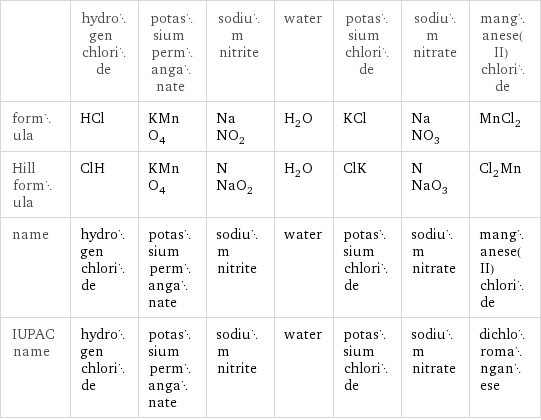
| hydrogen chloride | potassium permanganate | sodium nitrite | water | potassium chloride | sodium nitrate | manganese(II) chloride formula | HCl | KMnO_4 | NaNO_2 | H_2O | KCl | NaNO_3 | MnCl_2 Hill formula | ClH | KMnO_4 | NNaO_2 | H_2O | ClK | NNaO_3 | Cl_2Mn name | hydrogen chloride | potassium permanganate | sodium nitrite | water | potassium chloride | sodium nitrate | manganese(II) chloride IUPAC name | hydrogen chloride | potassium permanganate | sodium nitrite | water | potassium chloride | sodium nitrate | dichloromanganese